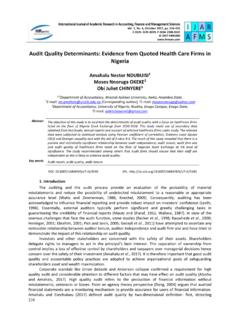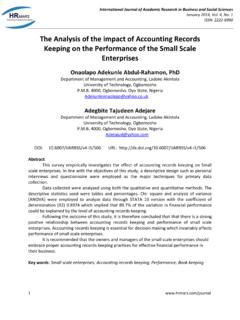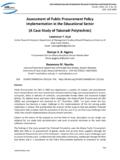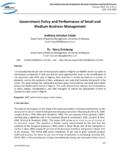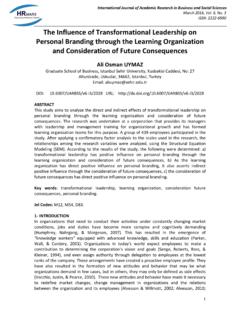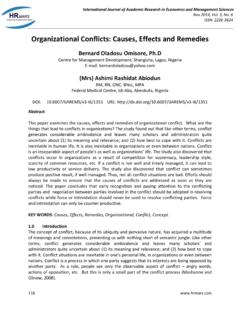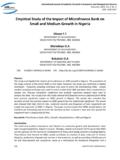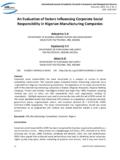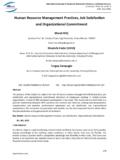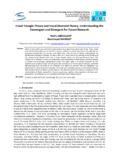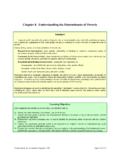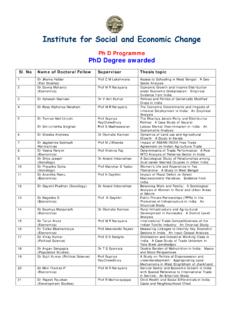Transcription of The Determinants of Financial Performance in the …
1 International Journal of Academic Research in Accounting, Finance and Management Sciences Vol. 4, , January 2014, pp. 299 308. E-ISSN: 2225-8329, P-ISSN: 2308-0337. 2014 HRMARS. The Determinants of Financial Performance in the Romanian Insurance Market Ana-Maria BURCA1. Ghiorghe BATR NCA2. 1. Faculty of Finance, Insurance, Banking and Stock Exchange, Department of Finance, Bucharest University of Economic 1. Studies, Bucharest, Romania, E-mail: 2. Faculty of Navigation and Naval Transport, Department of Economic Engineering in Transports, Constanta Maritime 2. University, Constanta, Romania, E-mail: Abstract The Financial analysis of a company is an important tool used by actuaries in the process of decision- making on underwriting and investment activities of the insurance company. The Financial Performance of insurance companies is also relevant within the macroeconomic context since the insurance industry is one of the Financial system' components, fostering economic growth and stability.
2 The Financial Performance of insurance companies can be analyzed at micro and macroeconomic level, being determined both by internal factors represented by specific characteristics of the company, and external factors regarding connected institutions and macroeconomic environment. This study attempts to analyze the Determinants of the Financial Performance in the Romanian insurance market during the period 2008 2012. According to the final results achieved by applying specific panel data techniques, the Determinants of the Financial Performance in the Romanian insurance market are the Financial leverage in insurance, company size, growth of gross written premiums, underwriting risk, risk retention ratio and solvency margin. Key words Financial Performance , Romanian insurance market, panel data, fixed effects model, random effects model DOI: URL: 1. Introduction Performance represents a difficult concept, both in terms of definition and quantification.
3 It was defined as output of activity, and the appropriate measure selected to assess corporate Performance is considered according to the organization type and objectives of evaluation. Researchers in strategic management have offered a variety of models that can be used to analyze Financial Performance . Nevertheless, there is no consensus on what constitutes a valid set of Performance criteria (Ostroff and Schmidt, 1993). Profitability, defined as proxy of Financial Performance , is one of the main objectives of insurance companies' management. Profit is an essential prerequisite for an increasing competitiveness of a company that operates in a globalized market. In addition, profit attracts investors and improves the level of solvency, and thus, strengthens consumers' confidence. The Financial analysis of a company is an important tool used by actuaries in the process of decision-making on underwriting and investment activities of the insurance company.
4 The Financial Performance of insurance companies is also relevant within the macroeconomic context since the insurance industry is one of the Financial system' components, fostering economic growth and stability. The Financial Performance of insurance companies can be analyzed at micro and macroeconomic level, being determined both by internal factors represented by specific characteristics of the company, and external factors regarding connected institutions and macroeconomic environment. Identifying the factors that contribute to insurance companies' profitability is useful for investors, researchers, Financial analysts and supervisory authorities. International Journal of Academic Research in Accounting, Finance and Management Sciences Vol. 4 (1), pp. 299 308, 2014 HRMARS. Although there are numerous approaches, generally, insurers' profitability is estimated through the examination of premium and investment income and of the underwriting results or of the overall operating Performance .
5 In order to get an accurate picture of insurers' profitability, it is important to consider the total loss or benefit resulting from the operations performed during several years, as any insurance company can have one unprofitable year, which is compensated by a certain form of profitability achieved over several years (Kearney, 2010). According to experts, the Romanian insurance market is below its potential, but has a significant value of approximately 2 billion . In terms of profitability as proxy of Financial Performance , the insurance companies from Romania are facing the combined effects of deteriorating market conditions and Financial crisis impact. 2. Literature review Research papers on Performance in insurance industry are scarce, and most of the papers on Financial Performance are focused on banks. As for Performance in insurance industry, most of the studies are recent, being performed after 2000. Among those performed before 2000, we can mention Spiller 1972, Chidambaran et al.
6 1997, Cummins and Weiss 1998, Genetay 1999. Within the context of rapid growth and development of offshore Financial centres, Adams and Buckle (2003) examine the Determinants of operational Performance in the Bermudian insurance market, during 1993 1997. By applying a model of panel data to 47 insurance companies, the authors highlight the fact that firms with high leverage, low liquidity and reinsurers have better operational Performance than those situated to the opposite pole. In terms of underwriting risk, contrary to expectations, the results indicate a positive relationship between this type of risk and insurers' operational Performance . Also, it was shown that company size and scope of activities are not factors with explanatory power. Shiu (2004) analyzes the Determinants of the Performance of the UK general insurance companies, over the period 1986 1999, by using three key indicators: investment yield, percentage change in shareholders' funds and return on shareholders' funds.
7 Based on a panel data set, the author empirically tested 12 explanatory variables and showed that the Performance of insurers have a positive correlation with the interest rate, return on equity, solvency margin and liquidity, and a negative correlation with inflation and reinsurance dependence. urak et al. (2011) examine the Determinants of the Financial Performance of the Croatian composite insurers, between 2004 and 2009. The Determinants of profitability, selected as explanatory variables include both internal factors specific to insurance companies and external factors specific to the economic environment. By applying panel data technique, the authors show that company size, underwriting risk, inflation and return on equity have a significant influence on insurers' profitability. The final results indicate that the Croatian insurance market has a low level of development, but it is very dynamic. Nowadays, insurance is one of the most profitable activities in European economies.
8 Based on this reality, Ikoni et al. (2011) analyze the profitability of the Serbian insurance companies by applying the IMF. CARMEL methodology. Thus, by determining 4 indicators related to the capital adequacy of insurers, the authors highlight that capital adequacy is vital for a company, as it may generate a good level of profitability. Their analysis indicates that the Serbian insurance market falls into the category of developed markets and that there are good perspectives of evolution. The integration of a country's Financial system within the EU markets significantly affects the profitability of the insurance sector. Based on these major changes, Kozak (2011) analyzes the Determinants of the profitability of 25 general insurance companies from Poland during 2002 2009. By applying a regression model, the author notices that the reduction of motor insurance and simultaneously the increase of other classes of insurance, growth of gross written premiums, operating costs reduction, GDP growth and growth of the market share of the companies with foreign ownership have a positive impact on insurance companies during the period of integration.
9 In contrast, providing a wide range of insurance classes affects negatively the profitability and the expenses efficiency. For a better understanding of the Financial Performance of the insurance sector from Pakistan, Malik (2011) examines 35 insurance companies, during the interval 2005 2009, by applying a multiple regression with 6 variables. Results emphasize that company size and volume of equity affects positively and 300. International Journal of Academic Research in Accounting, Finance and Management Sciences Vol. 4 (1), pp. 299 308, 2014 HRMARS. significantly the profitability of insurers, while leverage and loss ratio have a negative influence. The last variable tested, company age, does not affect the profitability of insurance companies. In countries with less developed economy, the insurance industry does not have an essential role in fostering economic growth due to the weak Financial Performance of insurers. In order to identify the factors that affect the Financial Performance of the Jordanian insurance market, Almajali et al.
10 (2012). analyze the insurance companies listed on the Amman Stock Exchange during 2002-2007, by applying tests and multiple regressions. Their study shows that, in terms of Financial Performance , liquidity, leverage, company size and management competence index have a statistical positive effect on insurers. In this context, their recommendations include increasing of assets' number and hiring competent managers. Life insurance companies manage significant amounts of money and, therefore, supervisory authorities monitor their Financial Performance . The first study of the Financial Performance of the Indian life insurers belongs to Charumathi (2012), who took into account a number of 6 independent variables. In India, life insurers' profitability is significantly and positively influenced by company size and liquidity, while leverage, growth of gross written premiums and volume of equity have a negative and significant influence.
